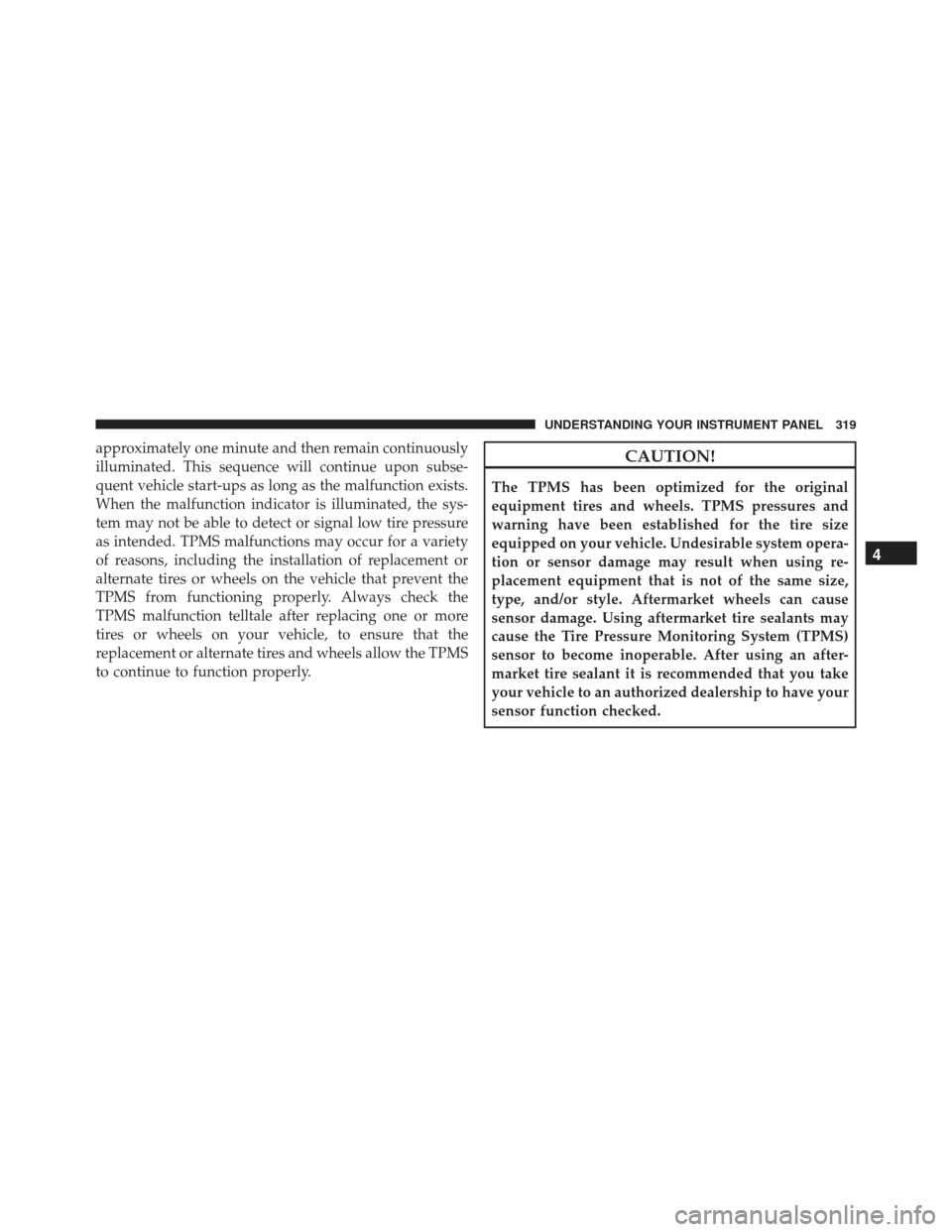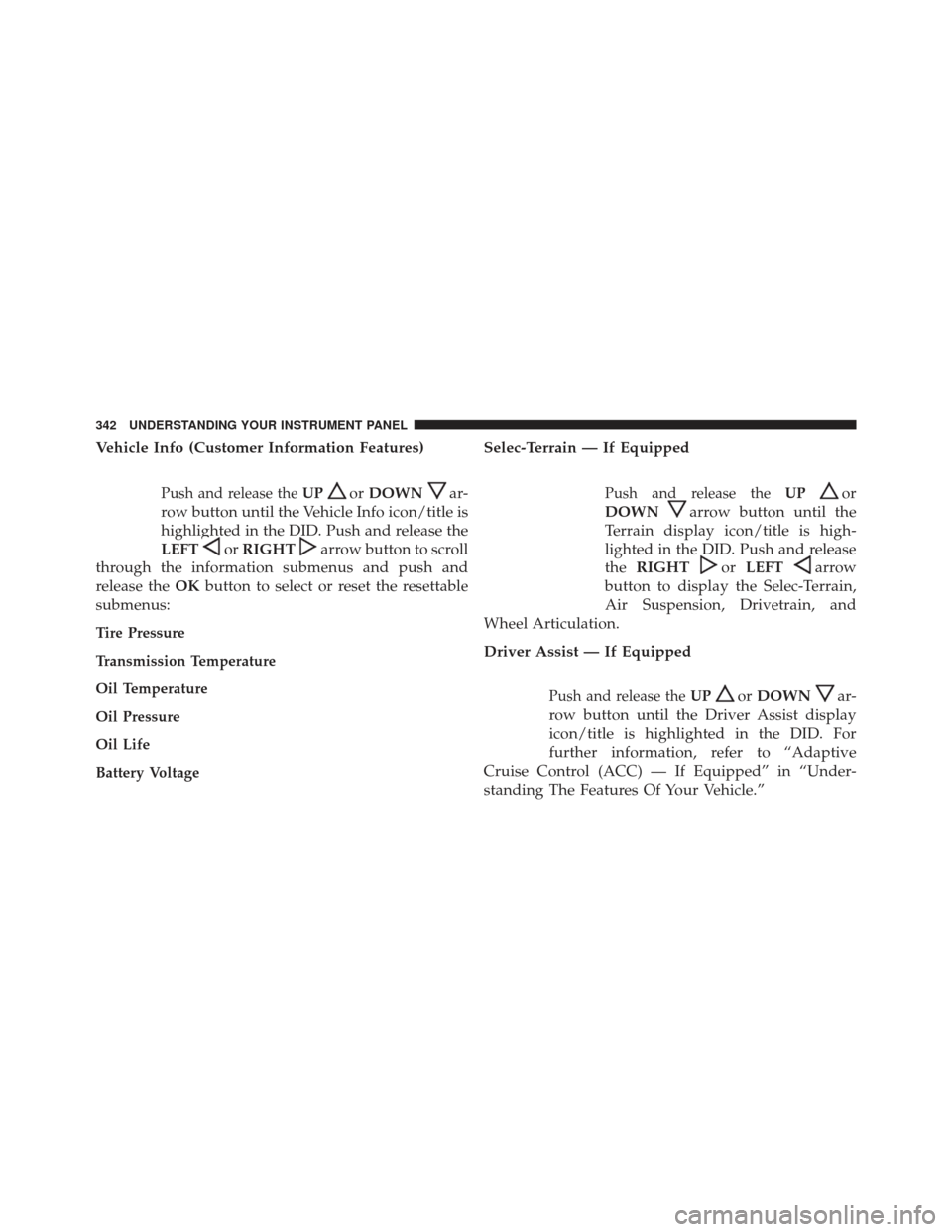Page 321 of 745

approximately one minute and then remain continuously
illuminated. This sequence will continue upon subse-
quent vehicle start-ups as long as the malfunction exists.
When the malfunction indicator is illuminated, the sys-
tem may not be able to detect or signal low tire pressure
as intended. TPMS malfunctions may occur for a variety
of reasons, including the installation of replacement or
alternate tires or wheels on the vehicle that prevent the
TPMS from functioning properly. Always check the
TPMS malfunction telltale after replacing one or more
tires or wheels on your vehicle, to ensure that the
replacement or alternate tires and wheels allow the TPMS
to continue to function properly.CAUTION!
The TPMS has been optimized for the original
equipment tires and wheels. TPMS pressures and
warning have been established for the tire size
equipped on your vehicle. Undesirable system opera-
tion or sensor damage may result when using re-
placement equipment that is not of the same size,
type, and/or style. Aftermarket wheels can cause
sensor damage. Using aftermarket tire sealants may
cause the Tire Pressure Monitoring System (TPMS)
sensor to become inoperable. After using an after-
market tire sealant it is recommended that you take
your vehicle to an authorized dealership to have your
sensor function checked.
4
UNDERSTANDING YOUR INSTRUMENT PANEL 319
Page 326 of 745
Service 4WD Indicator Light — If Equipped
Yellow TelltaleLight What It Means
Service 4WD Indicator Light
If the light stays on or comes on during driving, it means that the 4WD system is not function-
ing properly and that service is required. We recommend you drive to the nearest service center
and have the vehicle serviced immediately.
4WD Low Indicator Light — If Equipped
Yellow Telltale
Light What It Means
4WD Low Indicator Light
This light alerts the driver that the vehicle is in the four-wheel drive LOW mode. The front
and rear driveshafts are mechanically locked together forcing the front and rear wheels to
rotate at the same speed. Low range provides a greater gear reduction ratio to provide
increased torque at the wheels.
324 UNDERSTANDING YOUR INSTRUMENT PANEL
Page 327 of 745
Yellow TelltaleLight What It Means
Refer to “Four-Wheel Drive Operation — If Equipped” in “Starting And Operating” for
further information on four-wheel drive operation and proper use.
Air Suspension Light — If Equipped
Yellow Telltale Light What It Means
Air Suspension Light
This light will illuminate when the air suspension system is actively adjusting the ride
height.
4
UNDERSTANDING YOUR INSTRUMENT PANEL 325
Page 334 of 745
Hill Decent Control (HDC) Indicator Light — If Equipped
White TelltaleLight What It Means
Hill Decent Control (HDC) Indicator Light
This indicator shows when the Hill Descent Control (HDC) feature is turned on. The lamp
will be on solid when HDC is armed. HDC can only be armed when the transfer case is in
the “4WD LOW” position and the vehicle speed is less then 30 mph (48 km/h). If these
conditions are not met while attempting to use the HDC feature, the HDC indicator light
will flash on/off.
Selec Speed Control Indicator Light — If Equipped
White Telltale
Light What It Means
Selec Speed Control Indicator Light
This light will turn on when “Selec Speed Control” is activated.
To activate “Selec Speed Control”, assure the vehicle is Four Wheel Drive Low (4WD) and
push the button on the Instrument Panel.
332 UNDERSTANDING YOUR INSTRUMENT PANEL
Page 337 of 745
The system allows the driver to select information by
pushing the following buttons mounted on the steering
wheel:•
UP Arrow Button
Push and release the UParrow button to scroll
upward through the main menu and
submenus.
• DOWN Arrow Button
Push and release the DOWNarrow button to
scroll downward through the main menu and
submenus.
• RIGHT Arrow Button
Push and release the RIGHTarrow button to
access the information screens or submenu
screens of a main menu item.
• LEFT Arrow Button
Push and release the LEFTarrow button to
access the information screens or submenu
screens of a main menu item.
DID Buttons
4
UNDERSTANDING YOUR INSTRUMENT PANEL 335
Page 344 of 745

Vehicle Info (Customer Information Features)
Push and release theUPorDOWNar-
row button until the Vehicle Info icon/title is
highlighted in the DID. Push and release the
LEFT
or RIGHTarrow button to scroll
through the information submenus and push and
release the OKbutton to select or reset the resettable
submenus:
Tire Pressure
Transmission Temperature
Oil Temperature
Oil Pressure
Oil Life
Battery Voltage
Selec-Terrain — If Equipped
Push and release the UPor
DOWN
arrow button until the
Terrain display icon/title is high-
lighted in the DID. Push and release
the RIGHT
orLEFTarrow
button to display the Selec-Terrain,
Air Suspension, Drivetrain, and
Wheel Articulation.
Driver Assist — If Equipped
Push and release the UPorDOWNar-
row button until the Driver Assist display
icon/title is highlighted in the DID. For
further information, refer to “Adaptive
Cruise Control (ACC) — If Equipped” in “Under-
standing The Features Of Your Vehicle.”
342 UNDERSTANDING YOUR INSTRUMENT PANEL
Page 350 of 745

The electrical loads that may be switched off (if
equipped), and vehicle functions which can be effected
by load reduction:
•Heated Seat/Vented Seats/Heated Wheel
• Heated/Cooled Cup Holders — If Equipped
• Rear Defroster And Heated Mirrors
• HVAC System
• 115V AC Power Inverter System
• Audio and Telematics System
Loss of the battery charge may indicate one or more of
the following conditions:
• The charging system cannot deliver enough electrical
power to the vehicle system because the electrical
loads are larger than the capability of charging system.
The charging system is still functioning properly. •
Turning on all possible vehicle electrical loads (e.g.
HVAC to max settings, exterior and interior lights,
overloaded power outlets +12V, 115V AC, USB ports)
during certain driving conditions (city driving, tow-
ing, frequent stopping).
• Installing options like additional lights, upfitter elec-
trical accessories, audio systems, alarms and similar
devices.
• Unusual driving cycles (short trips separated by long
parking periods).
• The vehicle was parked for an extended period of time
(weeks, months).
• The battery was recently replaced and was not charged
completely.
• The battery was discharged by an electrical load left on
when the vehicle was parked.
348 UNDERSTANDING YOUR INSTRUMENT PANEL
Page 362 of 745

away. This gives you the most reaction time. To change
the setting for more dynamic driving, select the Near
setting. This warns you of a possible collision when you
are much closer to the vehicle in front of you. To change
the FCW status, press and release the “Near”, “Medium”
or “Far” button.
For further information, refer to “Forward Collision
Warning (FCW) With Mitigation” in “Understanding The
Features Of Your Vehicle”.
•Forward Collision Warning (FCW) Active Braking —
If Equipped
The FCW system includes Advanced Brake Assist (ABA).
When this feature is selected, the ABA applies additional
brake pressure when the driver requests insufficient
brake pressure to avoid a potential frontal collision. The
ABA system becomes active at 5 mph (8 km/h). To make
your selection, press the “Forward Collision Warning
(FCW) with Mitigation - Active Braking” button on the touchscreen, indicating that the setting had been selected.
For further information, refer to “Forward Collision
Warning (FCW) With Mitigation” in “Understanding The
Features Of Your Vehicle.”
•
Lane Departure Warning (LDW) — If Equipped
The Lane Departure Warning (LDW) sets the distance at
which the steering wheel will provide feedback for
potential lane departures. The LDW sensitivity can be set
to provide either an early, medium or late warning zone
start point. To make your selection, touch the “Lane
Departure Warning” soft-key, until a check-mark appears
next to setting, indicating that the setting had been
selected. Touch the back arrow soft-key to return to the
previous menu.
• Lane Departure Warning (LDW) Strength —
If Equipped
When this feature is selected, it sets the strength of the
steering wheel feedback for potential lane departures.
360 UNDERSTANDING YOUR INSTRUMENT PANEL